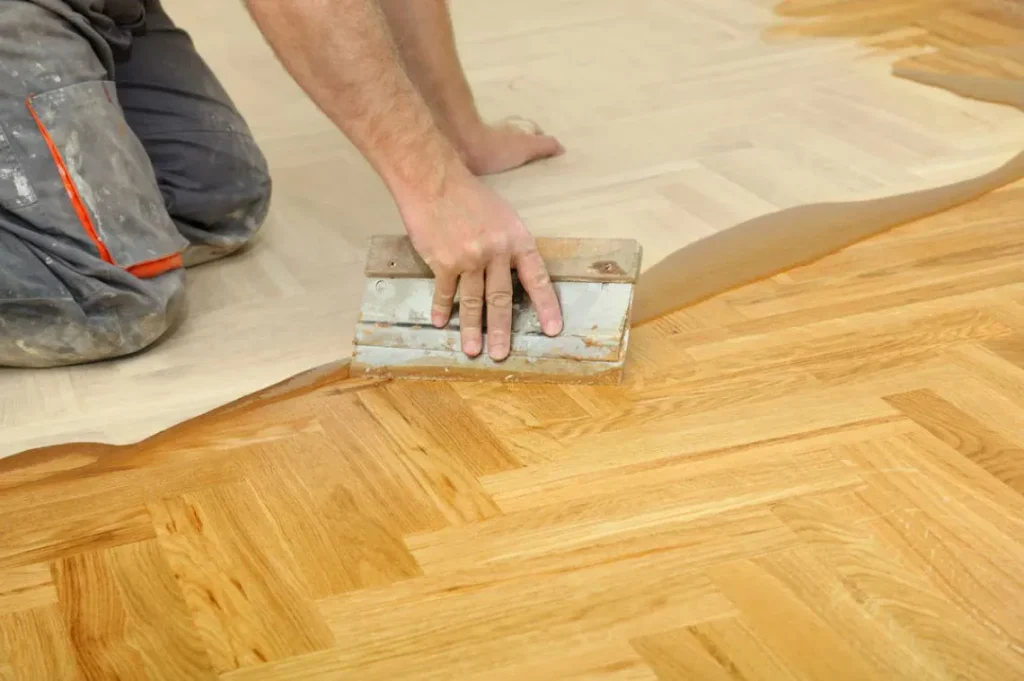Floor restoration, a practice that blends both art and science, is an essential undertaking for maintaining the longevity and beauty of various types of flooring materials. As floors age, they inevitably undergo wear and tear due to daily traffic, environmental conditions, or accidental damage. The process of floor restoration then becomes crucial in reversing these effects and reviving the original charm and character of aged floors.
This involves intricate tasks such as cleaning, sanding, repairing, staining, sealing and polishing which require not only technical skills but also a deep understanding of different flooring materials and their unique properties.
The complexity of floor restoration necessitates an appreciation for the science behind it while simultaneously recognizing its artistic aspects. On one hand is the scientific element encompassing material science that investigates how different varieties of wood or stone react to certain chemicals or treatments. It includes understanding factors like moisture content, hardness level or grain pattern which largely governs how a particular floor should be restored.
On the other hand is the artistry involved – applying meticulous attention to detail while performing each task; selecting suitable colors for staining that matches with overall décor; achieving an optimal balance between shine and matte finish during polishing stages among others. Thus floor restoration indeed stands at fascinating crossroads where artistic flair meets scientific precision.
Understanding the Basics of Floor Restoration
Delving into the basics of floor restoration reveals a complex blend of artistry and scientific precision, each contributing to the longevity and aesthetic appeal of various flooring types.
Floor restoration is a process that involves several stages such as evaluation, cleaning, repair or replacement, sanding, finishing and sealing. These steps are meticulously carried out in order to restore the original look or create an entirely new design. The type of material used for floors – hardwood, marble, ceramic tile among others – largely dictates the specific techniques and products employed in the restoration process.
The evaluation stage is crucial for determining the appropriate approach to take based on factors such as age and condition of the floor, level of wear and tear present and any previous treatments done.
Cleaning removes dirt and grime that may have accumulated over time using specific solutions that will not harm the surface while also preparing it for subsequent procedures.
Repair or replacement addresses any structural damage to ensure stability while sanding smoothens rough surfaces in preparation for finishing which enhances appearance through staining or painting.
Sealing then serves as protection against future damage by acting as a barrier against elements like water, dust and UV rays.
It is noteworthy to mention how advancements in science have greatly improved this field with new technologies providing more efficient ways of conducting these processes while minimizing environmental impact. For example, dustless sanding machines drastically reduce airborne particles during operation thereby promoting health safety. Similarly eco-friendly finishes offer durable protection without releasing harmful chemicals into our air space.
This harmonious marriage between artistry’s aesthetic appeal with science’s technical precision ensures that restored floors not only look good but last longer too – thus making floor restoration both an investment in property value enhancement as well as an expression of personal style preference within one’s living environment.
The Art and Science of Floor Restoration
Preserving the inherent beauty of a cherished surface requires a delicate blend of technical knowledge and aesthetic sensibility. The process of floor restoration, beyond being just a manual task, is an art that calls for an understanding of materials, their unique characteristics, and how different factors like time, traffic, and environment have contributed to their current state.
It involves intricately analyzing the composition of the floor material whether it be wood, marble or tile; identifying areas of deterioration; and determining the suitable methods for repair or replacement. The science part comes in when choosing appropriate cleaning agents and techniques to avoid further damage while restoring the original luster.
The technique employed in floor preservation varies depending on the type of flooring material. A seasoned professional will know that wooden floors require gentle sanding followed by staining or varnish application whereas stone surfaces may demand honing with diamond abrasives before polishing. Similarly, ceramic tiles might need grout color sealing to prevent dirt penetration after deep cleaning. These procedures necessitate not only proficiency but also an artistic eye able to envision what can be achieved with careful treatment – from preserving charming vintage features to creating contemporary finishes.
Delving into this realm uncovers how both artistry and scientific precision interplay in every step towards achieving a flawlessly restored floor. It’s about acknowledging each floor’s distinct narrative etched over years or perhaps decades and using specialized skills to carefully restore its former glory without erasing its historical character.
Moreover, it is about creating spaces that resonate with those who inhabit them – spaces where stories unfold and memories are made – enabling people to connect more deeply with their surroundings through appreciation for these meticulously preserved surfaces.
Floor Restoration Unleashed: Breathe New Life Into Old Spaces



